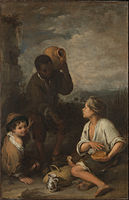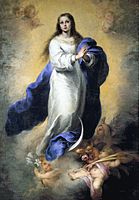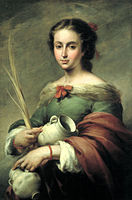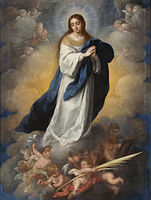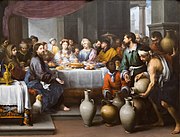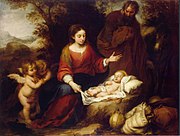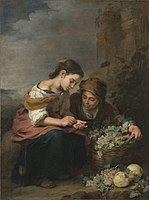art.wikisort.org - Artist
Bartolomé Esteban Murillo (/mjʊəˈrɪloʊ, m(j)ʊˈriːoʊ/ mure-IL-oh, m(y)uu-REE-oh, Spanish: [baɾtoloˈme esˈteβam muˈɾiʎo]; late December 1617, baptized January 1, 1618 – April 3, 1682) was a Spanish Baroque painter. Although he is best known for his religious works, Murillo also produced a considerable number of paintings of contemporary women and children. These lively, realist portraits of flower girls, street urchins, and beggars constitute an extensive and appealing record of the everyday life of his times. He also painted two self-portraits, one in the Frick Collection portraying him in his 30s, and one in London's National Gallery portraying him about 20 years later. In 2017-2018, the two museums held an exhibition of them.[1][2]
This article may be expanded with text translated from the corresponding article in Spanish. (November 2018) Click [show] for important translation instructions.
|
Bartolomé Esteban Murillo | |
|---|---|
 Self-portrait, c. 1670–1673 (detail) | |
| Born | late December 1617; baptised January 1, 1618 Seville, Crown of Castile (present-day Spain) |
| Died | April 3, 1682 (aged 64) Seville |
| Nationality | Spanish |
| Known for | painting, drawing |
| Movement | Baroque |
Childhood
Murillo was likely born in December of 1617 to Gaspar Esteban, an accomplished barber and surgeon, and María Pérez Murillo.[3] He may have been born in Seville or in Pilas, a smaller Andalusian town.[4] It is clear that he was baptized in Santa Maria Magdalena, a parish in Seville in 1618. After his parents died in 1627 and 1628, he became a ward of his older sister, Ana, and her husband, Juan Agustín Lagares, who coincidentally also happened to be a barber.[3] Murillo seemed to have remained close to the couple considering he did not leave their house until his marriage in 1645. 11 years later, he would be named the executor of Lagares' will despite his sister having already died.[5] Murillo seldom used his father's surname, and instead took his surname from his maternal grandmother, Elvira Murillo.[3]
Early life and formative years

There are few documents on the early years of Murillo's life or on his origins as a painter. In 1633, at 15, Murillo received a license for passage to America with his family.[6] He likely began his artistic career, either during those years, or slightly beforehand. Murillo began his art studies in Seville in the workshop of Juan del Castillo, Murillo's uncle and godfather, as well a skilled painter in his own right.[3] Castillo was characterized by the dryness of his sketches and the loving expressions in the subjects he painted, and Murillo took much of this as inspiration in his early work. His first works were also influenced by Francisco de Zurbarán, Jusepe de Ribera and Alonso Cano, and he shared their strongly realist approach. The great commercial importance of Seville at the time ensured that he was subject to artistic influences from other regions. He became familiar with Flemish painting and the "Treatise on Sacred Images" of Molanus (Ian van der Meulen or Molano). As his painting developed, his more important works evolved towards the polished style that suited the bourgeois and aristocratic tastes of the time, demonstrated especially in his Roman Catholic religious works.
According to fellow painter and art historian Antonio Palomino, Murillo left Castillo's workshop after feeling he had grown sufficiently skilled in his painting. In 1642, at the age of 26, he allegedly traveled to Madrid, where he most likely became familiar with the work of Velázquez, and saw the work of Francisco de Palacios; the rich colors and softly modeled forms of his subsequent work suggest these influences.[7] While it is likely that, like many Sevillian painters, Murillo took inspiration from religious images in an attempt to attract the lucrative American market, there is actually little evidence of Murillo traveling to Madrid. Similar claims, attributed by Joachim von Sandrart, a German historian of the time, argue that Murillo also travelled to Italy during the same period. Palomino denies these assertions, arguing that they stem from a refusal of foreigners to acknowledge that Murillo's success had come from Spain, and Spain alone.[8]
Palomino, instead, argued that Murillo's skill came from hours spent in his room, studying the natural world. He would use these skills when painting for the public, for the Franciscan convents throughout Spain, and for his fellow painters, who until then had little knowledge of his existence or art. In either case, his style could easily have been learned without leaving Seville from its previous generation of artists, such as Francisco de Zarbara or Francisco de Herrera the Elder.[8]
Career

In 1645, he returned to Seville and married Beatriz Cabrera y Villalobos, with whom he eventually had ten children.[3] Of these children, only 5 would outlive their mother, and only one, Gabriel (1655-1700) would carry on the work of Bartolome as a painter. The year of his marriage, Murillo received the first major commission of his career. This was to paint eleven canvases for the convent of San Francisco in Seville. He would work on this project from 1645-1648. These works depicted various stories of Franciscan saints which were not often told at the time. When selecting subjects, Murillo placed an emphasis on praising lives of contemplation and prayer as represented in paintings like Saint Francis Comforted by an Angel. His works vary between the Zurbaránesque tenebrism of the Ecstasy of St Francis and a softly luminous style (as in Death of St Clare) that became typical of Murillo's mature work.[3] According to the art historian Manuela B. Mena Marqués, "in ... the Levitation of St Giles (usually known as The Angels' Kitchen) and the Death of St Clare (Dresden, Gemäldegal. Alte Meister), the characteristic elements of Murillo’s work are already evident: the elegance and beauty of the female figures and the angels, the realism of the still-life details and the fusion of reality with the spiritual world, which is extraordinarily well developed in some of the compositions."[3] Similarly in Saint Diego Giving Alms, Murillo carefully places the paintng's subjects on parallel planes over black background, and its center, surrounding a boiling pot, are a group of children seemingly bathed in a heavenly glow. In doing so, Murillo managed to combine both tenebrism and luminosity to showcase the glory of aiding the needy and the innocent.
Also completed c. 1645 was the first of Murillo's many paintings of children, The Young Beggar (Musée du Louvre), in which the influence of Velázquez is apparent.[3] Following the completion of a pair of pictures for the Seville Cathedral, he began to specialize in the themes that brought him his greatest successes: the Virgin and Child and the Immaculate Conception.[9]
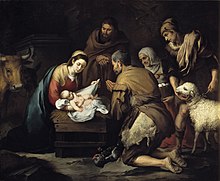
After another period in Madrid, from 1658 to 1660, he returned to Seville. Here he was one of the founders of the Academia de Bellas Artes (Academy of Art), sharing its direction, in 1660, with the architect Francisco Herrera the Younger. This was his period of greatest activity, and he received numerous important commissions, among them the altarpieces for the Augustinian monastery, the paintings for Santa María la Blanca[10] (completed in 1665), and others.[3] He died in Seville in 1682, a few months after he fell from a scaffold while working on a fresco at the church of the Capuchines in Cádiz.[3]
Legacy
Murillo had many pupils and followers. The prolific imitation of his paintings ensured his reputation in Spain and fame throughout Europe, and prior to the 19th century his work was more widely known than that of any other Spanish artist.[7] Artists influenced by his style included Gainsborough and Greuze.[3] Google marked the 400 years since Murillo's birth with a doodle on 29 November 2018.[11]
Public collections

The Museo del Prado in Madrid; Hermitage Museum in Saint Petersburg, Russia (such as Boy with a Dog); and the Wallace Collection in London are among the museums holding works by Murillo. His painting “The Coronation in Heaven of the Mother of God” is on display at the Basilica of St. Joseph Proto-Cathedralin Bardstown Kentucky. His painting Christ on the Cross is at the Timken Museum of Art in San Diego.[12] Christ After the Flagellation is at the Krannert Art Museum, Champaign, Illinois.[13] His work is also found at the Mabee-Gerrer Museum of Art in Shawnee, Oklahoma, and at the Meadows Museum at Southern Methodist University in Dallas, Texas.[14]
Selected works
- Joseph and Potiphar's Wife, c. 1640–1645, Gemäldegalerie Alte Meister
- Young Man with a Basket of Fruit or Personification of Summer, c. 1640–1650
- The Girl with a Coin or Girl of Galicia, c. 1645–1650
- The Young Beggar, c. 1645, Musée du Louvre, Paris, France
- Boys Eating Grapes and Melon, c. 1645–46, Alte Pinakothek
- St. Jerome, c. 1650–1652
- St. Peter in Tears, c. 1650–1655, Bilbao Fine Arts Museum
- The Virgin of the Rosary, c. 1650–1655, Museo del Prado
 St. Isidore of Sevilla, 1654, Cathedral of Seville, Spain
St. Isidore of Sevilla, 1654, Cathedral of Seville, Spain- Annunciation, c. 1655–1660, Hermitage Museum, Russia
- Adoration of the Magi, c. 1660
- Apparition of the Virgin to St. Ildefonsus, c. 1660
- Three Boys, c. 1660
- The Immaculate Conception of El Escorial, c. 1660-1665
- St. Justa, c. 1665
- St. Rufina, c. 1665
- Christ Healing the Paralytic at the Pool of Bethesda, 1670
- Saint Rose of Lima, c. 1670. Lazaro Galdiano Museum, Madrid.
- The Immaculate Conception of the Blessed Virgin Mary, 1678
- St. Raphael the Archangel with Bishop Domonte, c. 1680, Pushkin Museum
- The Marriage Feast at Cana, c. 1672, The Barber Institute of Fine Arts
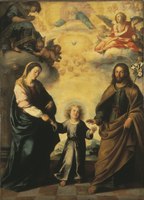 The Return of the Holy Family from Egypt, Nationalmuseum, Stockholm
The Return of the Holy Family from Egypt, Nationalmuseum, Stockholm- Virgin and Child with Saint Rose of Viterbo. Thyssen-Bornemisza Museum, Madrid.
- Rest on the Flight into Egypt, c. 1665 Hermitage Museum, Moscow
- The Little Fruitseller, c.1670-1675, Alte Pinakothek, Munich
References
- Murillo: The Self-Portraits (Frick)
- Murillo: The Self-Portraits (National Gallery)
- Marqués, Manuela B. Mena. "Murillo, Bartolomé Esteban." Grove Art Online. Oxford Art Online. Oxford University Press.
- A., O'Neill (1833). A Dictionary of Spanish Painters. London: C. O'Neill. p. 246.
- Lopez Gutiérrez, Antonio J; Ortega López, Aurora J. "Los Esteban Murillo: una familia de feligreses en la Parroquia de Santa María Magdalena" (PDF). Cartografía Murillesca. Año de Murillo MMXVII - Los Pasos Contados.
- Hereza, Pablo (2017). Corpus Murillo : biografía y documentos. Sevilla. ISBN 978-84-9102-052-3. OCLC 1016437605.
- "Bartolome Esteban Murillo". Encyclopædia Britannica, Inc. Retrieved 2007-08-30.
- Palomino de Castro y Velasco, Antonio (1988). El Museo pictórico y escala óptica. Madrid: M. Aguilar. ISBN 84-03-88901-1. OCLC 802896585.
- The center medallion of the badge of the Spanish Order of Charles III is clearly modeled on Murillo's unique manner of representing the Immaculate Conception.
- Santa María la Blanca
- Picheta, Rob (29 November 2018). "Bartolome Esteban Murillo, Spanish baroque painter, gets the Google Doodle treatment". CNN. Retrieved 4 June 2019.
- "Christ on the Cross". Timken Museum of Art. Archived from the original on 2011-11-27.
- "Christ After the Flagellation". Krannert Art Museum.
- "Bartolomé Esteban MURILLO". Meadows Museum. Archived from the original on 2012-09-10. Retrieved 2012-12-08.
Further reading
- Palomino, Antonio (1988). El museo pictórico y escala óptica III. El parnaso español pintoresco laureado. Madrid : Aguilar S.A. de Ediciones. ISBN 84-03-88005-7.
- Murillo's painting The Spanish Page is the subject of an ekphrastic poem by Letitia Elizabeth Landon in Fisher's Drawing Room Scrap Book, 1837. See
 The Spanish Page.
The Spanish Page. - Xavier F. Salomon and Letizia Treves, Murillo: The Self-Portraits. New York: The Frick Collection, 2017. Accompanied exhibition
External links
- 100 artworks by or after Bartolomé Esteban Murillo at the Art UK site
- Scholarly articles in English about Bartolomé Esteban Murillo both in web and PDF @ the Spanish Old Masters Gallery
- Paintings in Museums and Public Art Galleries Worldwide
- Murillo Biography, Style and Critical Reception
- Murillo Gallery at MuseumSyndicate
- Herbermann, Charles, ed. (1913). . Catholic Encyclopedia. New York: Robert Appleton Company.
- Murillo at ArtRenewalCenter
 The Madonna and Child., engraved by Robert Graves for The Easter Gift, 1832, with a poetical illustration by Letitia Elizabeth Landon
The Madonna and Child., engraved by Robert Graves for The Easter Gift, 1832, with a poetical illustration by Letitia Elizabeth Landon Infant St. John the Baptist., engraved by Samuel Davenport for The Easter Gift, 1832, with a poetical illustration by Letitia Elizabeth Landon
Infant St. John the Baptist., engraved by Samuel Davenport for The Easter Gift, 1832, with a poetical illustration by Letitia Elizabeth Landon
На других языках
[de] Bartolomé Esteban Murillo
Bartolomé Esteban Murillo (1617[1] in Sevilla, Andalusien; † 3. April 1682 ebenda) war ein spanischer Maler des Barocks und ab der Mitte des 17. Jahrhunderts der führende und berühmteste Maler Sevillas.- [en] Bartolomé Esteban Murillo
[es] Bartolomé Esteban Murillo
Bartolomé Esteban Murillo (Sevilla, bautizado el 1 de enero de 1618-3 de abril de 1682) fue un pintor barroco español. Formado en el naturalismo tardío, evolucionó hacia fórmulas propias del barroco pleno con una sensibilidad que a veces anticipa el rococó en algunas de sus más peculiares e imitadas creaciones iconográficas, como la Inmaculada Concepción o el Buen Pastor en figura infantil. Personalidad central de la escuela sevillana, con un elevado número de discípulos y seguidores que llevaron su influencia hasta bien entrado el siglo XVIII, fue también el pintor español mejor conocido y más apreciado fuera de España, el único del que Sandrart incluyó una breve y fabulada biografía en su Academia picturae eruditae de 1683 con el Autorretrato del pintor grabado por Richard Collin.[2] Condicionado por la clientela, el grueso de su producción está formado por obras de carácter religioso con destino a iglesias y conventos sevillanos tanto como a la devoción privada, pero a diferencia de otros grandes maestros españoles de su tiempo cultivó también la pintura de género de forma continuada e independiente a lo largo de buena parte de su carrera.[3][fr] Bartolomé Esteban Murillo
Bartolomé Esteban Murillo, né à Séville probablement le 31 décembre 1617 et mort dans la même ville le 3 avril 1682[1], est un peintre baroque espagnol.[it] Bartolomé Esteban Murillo
Bartolomé Esteban Pérez Murillo (Siviglia, 1º gennaio 1618 – Cadice, 3 aprile 1682) è stato un pittore spagnolo. Assieme a Diego Velázquez, Francisco de Zurbarán e José de Ribera è una delle figure più rappresentative della pittura barocca spagnola durante il Siglo de Oro. Sebbene grossa parte della sua attività sia stata la realizzazione di soggetti a carattere religioso rimane particolarmente famoso per le sue scene di genere in cui rappresenta donne e soprattutto ragazzini della classe popolare.[ru] Мурильо, Бартоломе Эстебан
Бартоломе́ Эстеба́н Мури́льо (исп. Bartolomé Esteban Murillo; род. предположительно 31 декабря 1617[2], крещён 1 января 1618, Севилья — 3 апреля 1682, там же) — ведущий испанский живописец «золотого века», глава севильской школы.Другой контент может иметь иную лицензию. Перед использованием материалов сайта WikiSort.org внимательно изучите правила лицензирования конкретных элементов наполнения сайта.
WikiSort.org - проект по пересортировке и дополнению контента Википедии












